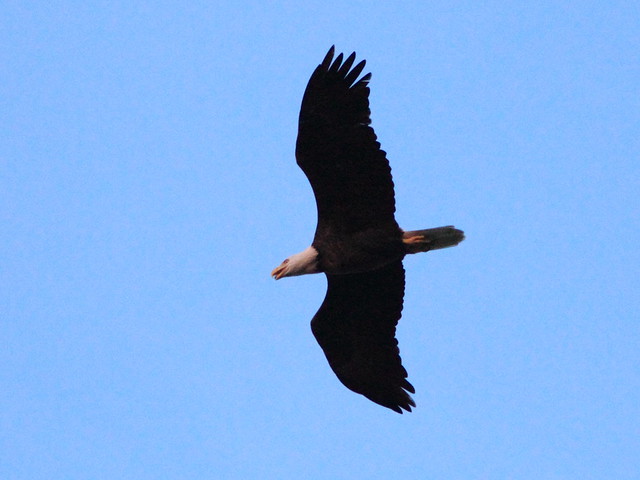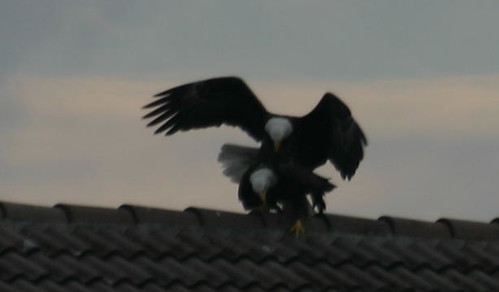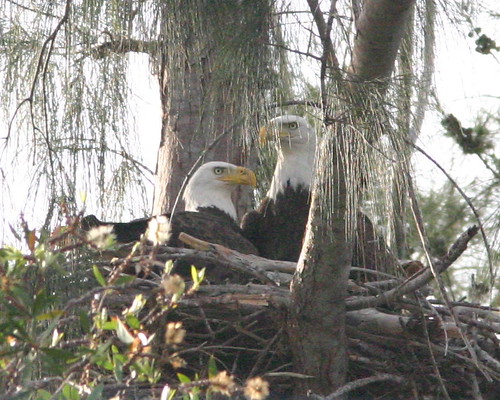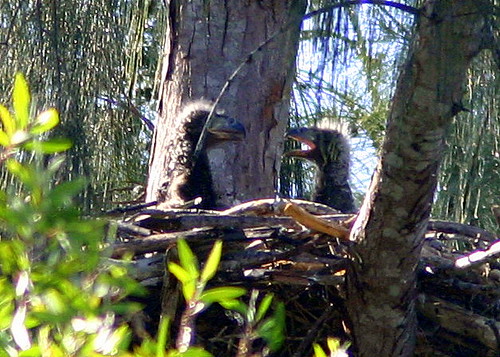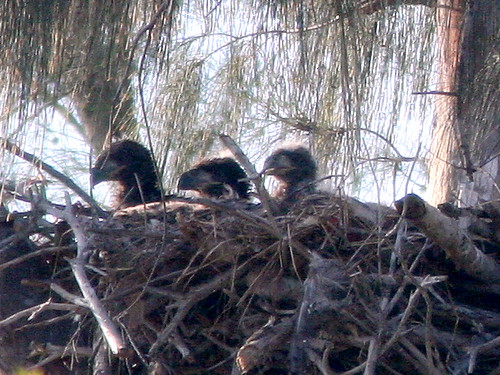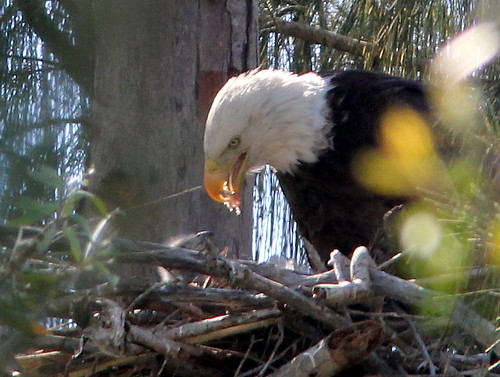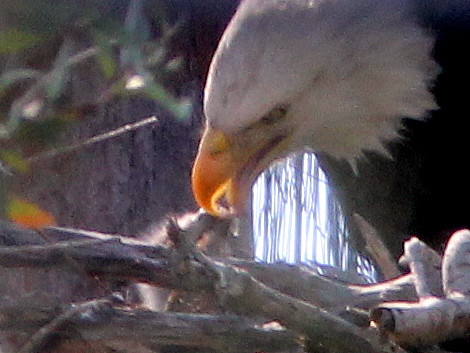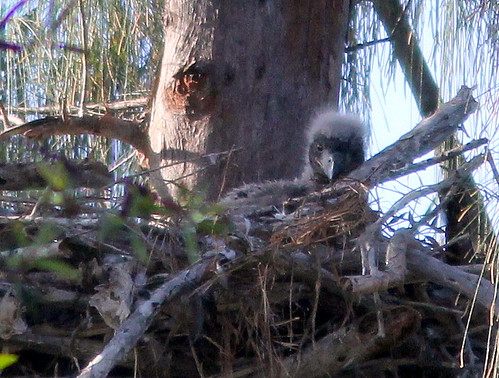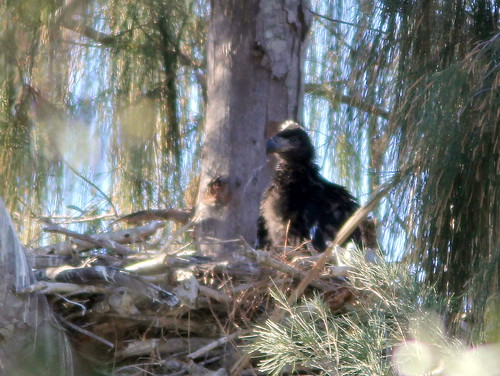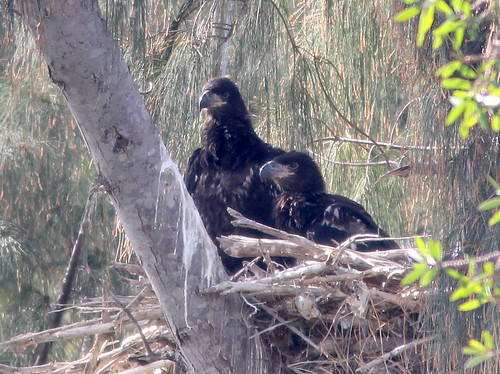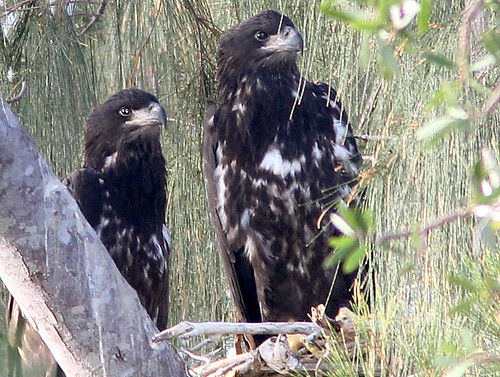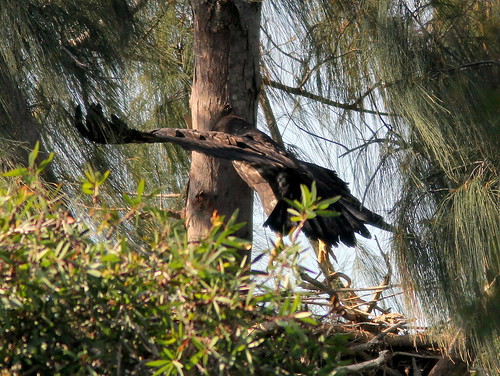Posted by: Ken @ 2:11 pm
With good reason, Alaska usually comes to mind at any mention of Bald Eagles. Yet, it surprises some people to learn that, in the lower 48 states, breeding Bald Eagles are most numerous in Florida and Minnesota. In 1990 there were 535 breeding pairs in Florida, and 437 in Minnesota. The number of Florida breeding pairs rebounded rapidly to 1,102 pairs in 2001, then plateaued at 1,133 in 2005. In the meantime, Minnesota’s population climbed slowly at first, to 681 pairs in 2001, then shot up to 1,312 pairs in 2005, surpassing the Florida population.
This US Fish and Wildlife Service graph illustrates the recovery of breeding Bald Eagles in the lower 48 states since DDT was banned in the early 1970s:
In an earlier post, I described why the numbers of Bald Eagles in the more northern of the lower 48 states increase during summer and early autumn, due not only to newly fledged eaglets, but to the influx of more southern eagles. The Florida birds perform an interesting “reverse” northward migration after the breeding season. It is hypothesized that this contrary behavior is caused by another sort of “migration,” namely the vertical movement of the eagles’ main food source.
As Florida’s lakes heat up, the fish seek cooler temperatures in deeper water. Radio tagging of Florida eagles has shown that many follow the cooler water into the northeastern coastal states. Chesapeake Bay is a popular summer and fall gathering place for the Florida population.Immature birds tend to wander more widely than adults, with some even ending up in Canada. Conversely, North America’s northernmost Bald Eagles move south with the approach of winter, seeking open water as the larger lakes freeze up.
Alaskan eagles are, on average, heavier than those in Florida and have longer wings. I photographed this one in Soldotna, Alaska, along the Kenai River:
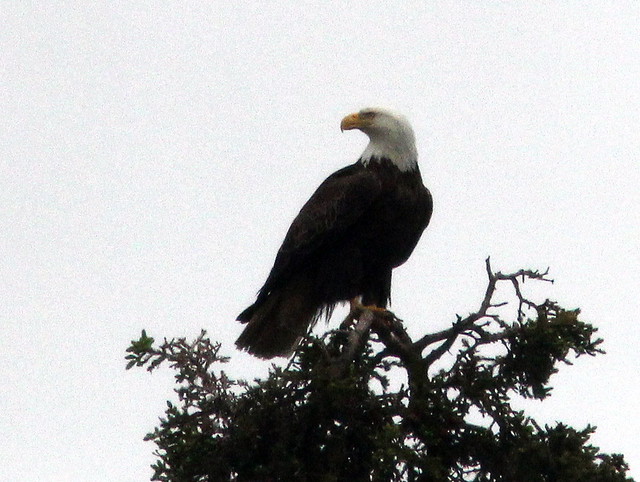
We have a particular interest in Bald Eagles, as we have been involved in protecting a recently discovered nest in our south Florida neighborhood. During the first week of October, 2011, Mary Lou and I were pleased to see that both members of the pair had returned to the nest: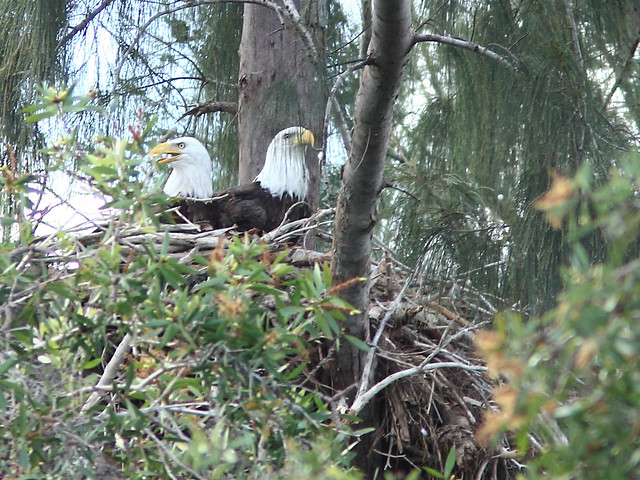
They were already rearranging the nest materials: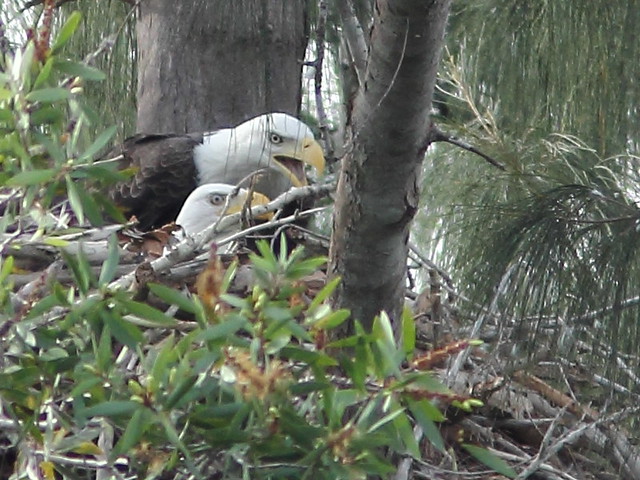
On October 12, 2011, I photographed one of the pair at sunrise, flying from the nest area in the general direction of the largest lake in our subdivision:
On October 16, 2011, the female was sitting high on the nest…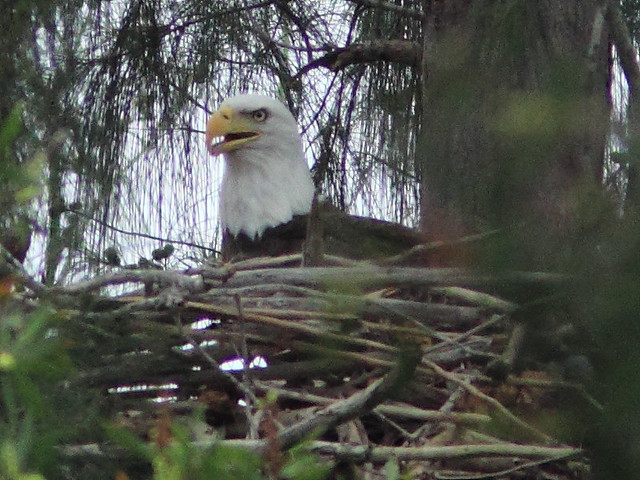
…while her mate (judging by its slimmer build and slightly smaller size) roosted in a nearby Australian Pine: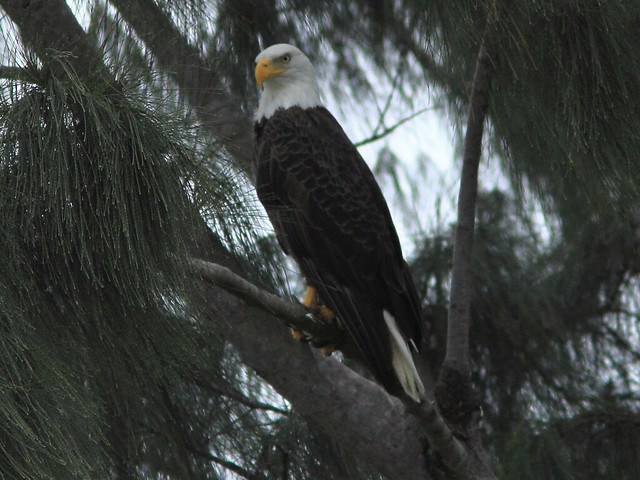
We first became aware of the local pair of eagles on December 4, 2007, when I photographed them mating on the rooftop of a house just across the lake from our home:
As there had not been a record of an active Bald Eagle nest in Broward County since several years before DDT was abolished in the early 1970s, I reported the sighting on the Tropical Audubon Society’s Web page, and birders in neighboring Pembroke Pines had a general idea of where they might be breeding. In March, 2008, Kelly Smith, a local middle school teacher found the nest, located only about 150 feet from a busy boulevard. It contained one nearly full-grown eaglet.
This photo of “P. Piney One” was taken by Kelly Smith on March 15, 2008 and is reproduced here with her permission:
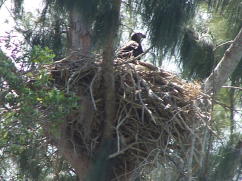
This pair of eagles has returned to the same nest each year, successfully raising and fledging two chicks in 2009, three in 2010, and two more this past spring. The nest is about 50 feet high in an exotic Australian Pine tree with smaller trees blocking most of the view, so we only get distant looks.
On December 11, 2008, both adults are shown sitting on the nest, only two days before the first of two eggs was laid::
Local middle school students conducted a nationwide poll that chose names for the two eaglets, “Hope” and “Justice:” They hatched on January 15,2009. Here they are, squabbling with each other at exactly one month of age. Hope, the older and larger, is on the left:
The eagle nest attracted a great deal of attention, and crowds of up to 100 people came to see the antics of the eaglets, causing traffic hazards as they stopped on the roadway and parked illegally.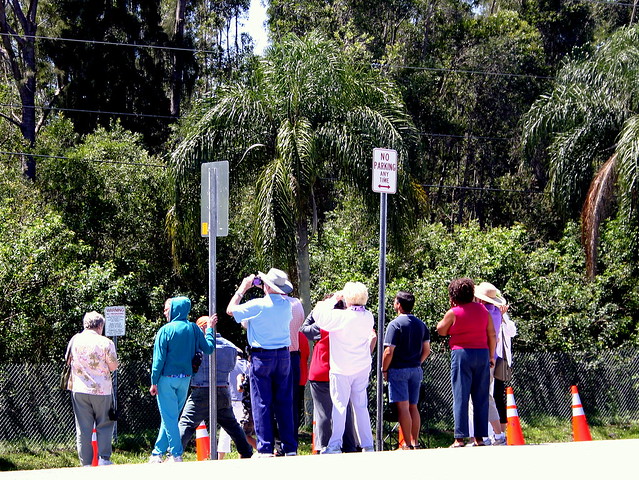
The Mayor took an interest in the nest, which is located on City of Pembroke Pines property, and he announced his intention to declare the site a City Bald Eagle Sanctuary, and took measures to protect both the eagles and observers.The City has amended its planning documents to pave the way for an ordinance that will provide safeguards against disturbance of any eagle nest in the city. This past summer, major resurfacing of the roadway and construction of a sidewalk were suspended in the area of the nest during the eagles’ breeding season (May 15 - October 1).
I photographed these three eaglets on March 2, 2010. The Middle School students’ poll resulted in them being named Chance, Lucky and Courage. All three fledged successfully:
The eagles returned in October, 2010 to refurbish the nest, and eggs were laid around December 11. ( * See end note about how we estimate the time of egg laying and hatching). On January 23, 2011 at the age of about 9 days, this chick was first seen, peering over the nest rim: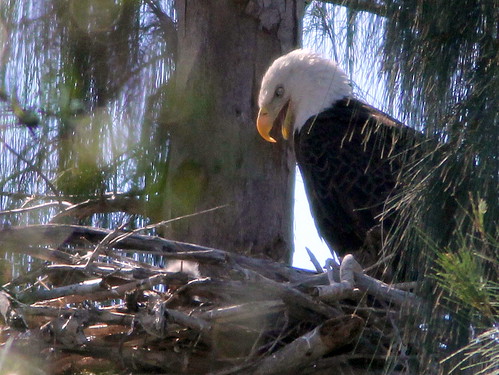
Here, it waits as its parent tears off a bit of food. A younger sibling was not yet visible from the ground:
The Parent eagle feeds the chick :
This was about as good a view we could get from 150 feet. Vegetation now makes viewing much more difficult. Plans for a nest camera did not materialize:
Here is the older of the two eaglets, on February 3, 2011. Much of her natal down has already disappeared:
At one month old, on February 15, 2011, the down had been reduced to a fuzzy cap:
Less than two weeks later, on February 27, 2011, the eaglets looked almost as large as adults. We called them “P. Piney Seven & Eight.” Bald Eagles exhibit sexual dimorphism that starts when they are nestlings, with the females usually considerably larger than males. PP 7 is the larger and was presumed to be a female:
At two and a half months of age on March 23, 2011 they were exercising their wings, preparing for their first flight, which usually occurs when they are between 10 and 12 weeks old. PP7, on the right, has more white underneath than her younger brother:
On March 30, 2011, we found PP8 alone in the nest; PP7 had flown off, but returned within three days to be fed: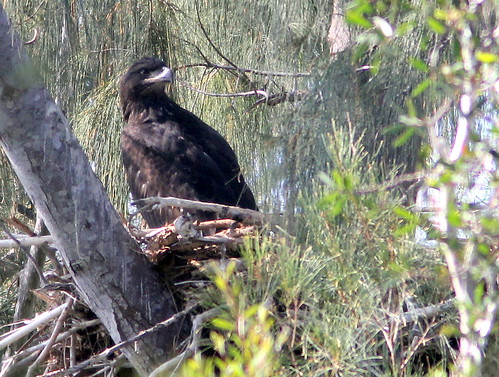
On March 30, PP8 was “helicoptering,” hovering in place up to a foot off the ground:
Here, on April 3, 2011, my last shot of PP7 shows her roosting in a tree next to the nest. PP8 was flying back and forth on branches in the nest tree: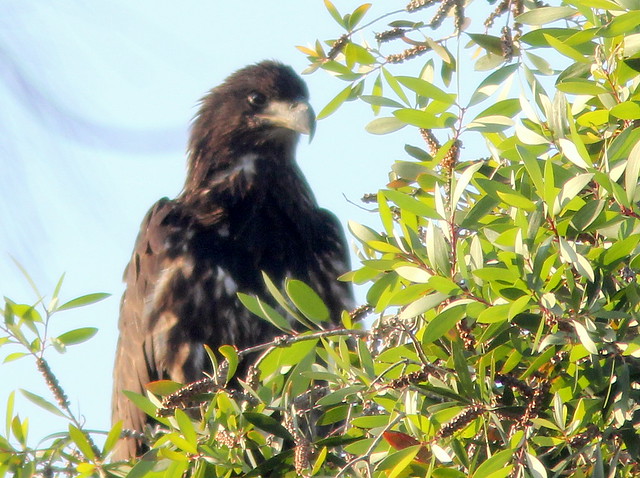
*In estimating the timing of the laying of eggs and hatching of the eaglets, we must depend upon clues from changes in the behavior of the adults. The onset of incubation coincides with the laying of the first egg, which is when we suddenly see one of the pair down deep and immobile in the nest. Hatching is a time of excitement, as the parents shift position frequently, peer down into the nest, and they start bringing in prey and tearing off bits to feed the tiny chick. The adults also sit a bit higher in the nest after the first egg hatches, supporting themselves on their wings to form a “tent” to shelter the chick and yet provide warmth to any eggs that have not yet hatched.













